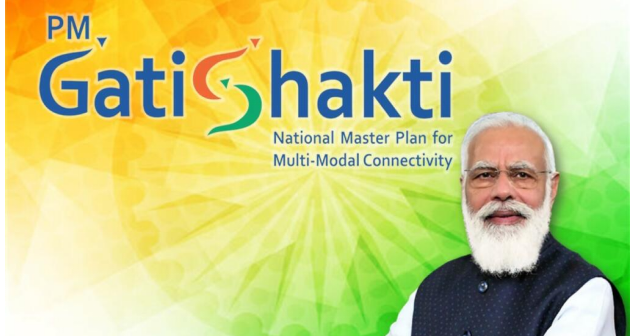The PM Gati Shakti project is a transformative initiative launched by the Indian government to boost the country’s infrastructure and accelerate economic growth. This ambitious plan integrates various infrastructure schemes under a single framework, aimed at streamlining and optimizing logistics, enhancing connectivity, and reducing transportation costs. By focusing on multi-modal connectivity and breaking down silos, Gati Shakti promises to have far-reaching impacts on the Indian industry and economy.
What is the PM Gati Shakti Project?
Launched in October 2021, the PM Gati Shakti project is a national master plan designed to create seamless connectivity across different sectors and states in India. The initiative emphasizes the integration of infrastructure projects across highways, railways, ports, airports, inland waterways, and public transport. It aims to connect rural and urban areas, improve industrial zones, and facilitate the movement of goods and people efficiently.
Key Components and Goals of PM Gati Shakti
- Multi-Modal Connectivity: The project aims to provide integrated and seamless connectivity for the movement of people, goods, and services. It connects multiple transport modes, including roads, railways, ports, and airways, creating a network that reduces travel time and logistics costs.
- Unified Planning and Coordination: By integrating various government departments and ministries, Gati Shakti ensures that infrastructure projects are planned and executed in a coordinated manner. This approach reduces redundancy, prevents delays, and ensures optimal use of resources.
- Data-Driven Decision Making: The project utilizes a Geographic Information System (GIS)-based platform that allows real-time monitoring and decision-making. This platform provides data on existing infrastructure, identifies gaps, and helps plan future projects effectively.
- Boosting Manufacturing and Industrial Growth: By improving logistics and reducing costs, Gati Shakti aims to make Indian manufacturing more competitive. The project is aligned with the government’s vision of making India a global manufacturing hub by improving supply chain efficiency and reducing bottlenecks.
Impact on Indian Industry
- Enhanced Efficiency and Reduced Costs: The Gati Shakti project focuses on reducing logistical costs, which currently account for 13-14% of India’s GDP. By providing seamless connectivity and reducing transit times, the project aims to bring down these costs to about 8% of GDP, in line with global standards. This reduction in logistics costs will make Indian products more competitive in both domestic and international markets.
- Improvement in Supply Chain Management: By integrating transport networks, Gati Shakti will enhance supply chain efficiency, reducing lead times for manufacturers and improving the reliability of supply chains. This improvement is critical for sectors such as automobile manufacturing, electronics, and fast-moving consumer goods (FMCG), where just-in-time delivery is essential.
- Boost to Manufacturing and Exports: Improved infrastructure will directly benefit the manufacturing sector, which is a key pillar of India’s economic growth. By reducing costs and improving efficiency, Gati Shakti is expected to give a significant boost to manufacturing output. This, in turn, will enhance India’s export competitiveness, helping the country achieve its target of a $1 trillion export economy.
- Promotion of Industrial Clusters: The project will facilitate the development of industrial corridors and special economic zones (SEZs) by providing the necessary connectivity and infrastructure. These clusters will attract investment, promote innovation, and create employment opportunities, contributing to economic growth.
Impact on the Indian Economy
- Economic Growth and Job Creation: Gati Shakti is expected to attract significant investments in infrastructure, estimated to be around ₹100 lakh crore over the next few years. This massive investment will spur economic growth, generate employment, and improve the standard of living. The construction sector, in particular, will benefit from increased demand for infrastructure development.
- Regional Development and Inclusivity: The project aims to connect remote and underserved regions of the country, promoting balanced regional development. By improving connectivity and providing access to markets, Gati Shakti will enable rural and semi-urban areas to participate in economic activities, reducing regional disparities.
- Sustainability and Environmental Benefits: By optimizing transport networks and reducing congestion, Gati Shakti will contribute to lower emissions and a reduction in the carbon footprint. The project also emphasizes the use of renewable energy sources and sustainable construction practices, aligning with India’s commitment to environmental sustainability.
- Attracting Foreign Investment: Improved infrastructure and ease of doing business will make India a more attractive destination for foreign investors. By providing world-class infrastructure, Gati Shakti will enhance India’s image as a global investment hub, attracting multinational companies and boosting foreign direct investment (FDI).
Conclusion
The PM Gati Shakti project is a visionary initiative that promises to transform India’s infrastructure landscape and boost its economic growth. By providing seamless connectivity, reducing costs, and enhancing efficiency, the project will have a profound impact on the Indian industry and economy. As India continues to pursue its goal of becoming a $5 trillion economy, Gati Shakti will play a pivotal role in achieving this vision, driving prosperity and development across the nation.





